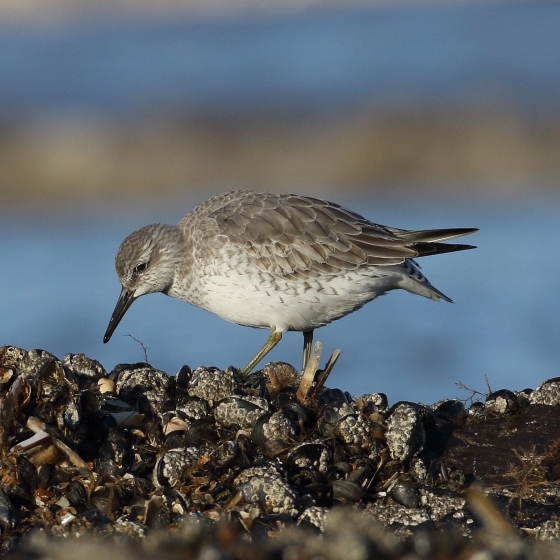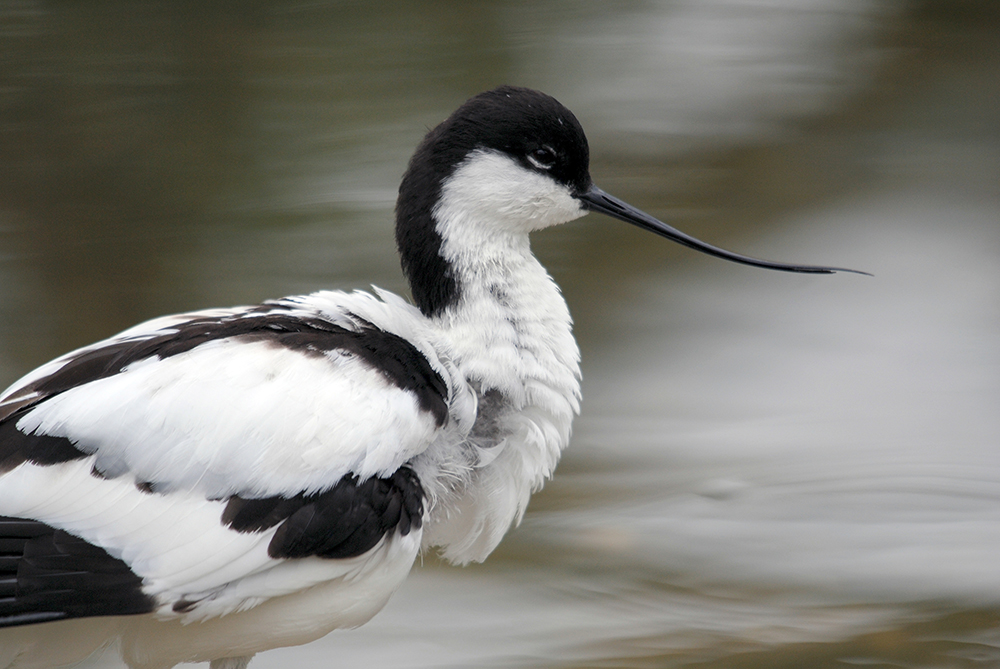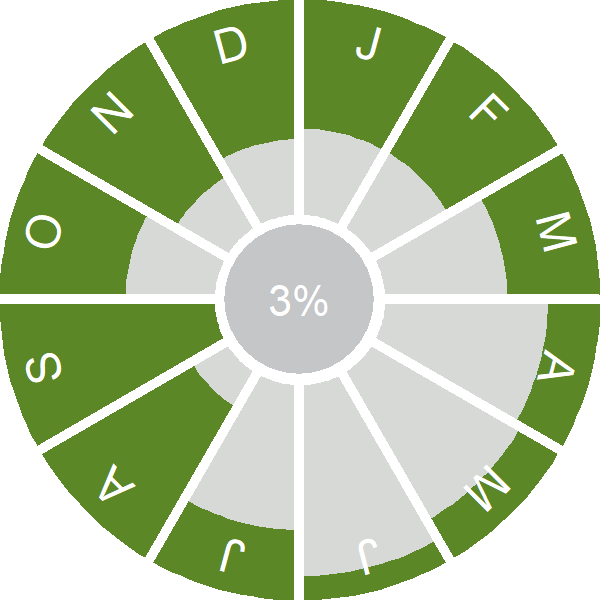Knot

Introduction
This medium-sized grey wader winters on our larger estuaries before returning to its Arctic breeding grounds.
Although the Knot's winter plumage is uniformly pale grey, birds start gaining brick-red feathering in the spring as they depart for their breeding grounds. Early in the winter, juvenile birds can be identified by a 'scalloped' appearance – each feather has a black line near its edge.
Ringing data show that our wintering Knot come mostly from Iceland, Greenland and the Canadian Arctic. WeBS counts show that The Wash hosts the vast majority of this population, with mid-winter peak counts having increased to in the region of 200,000 birds. Watching their swirling flocks is a true wildlife spectacle.

Key Stats
Identification
ID Videos
This section features BTO training videos headlining this species, or featuring it as a potential confusion species.
Knot and Dunlin
Ruff
Songs and Calls
Call:
Flight call:
Status and Trends
Conservation Status
Population Change
Two races of Knot (out of six worldwide) use the UK's estuaries in winter. The canutus race, that breed in Siberia, are seen here on autumn passage, while the islandica race, that breed in Greenland and Canada, winter here; the UK hosts 80% of the entire islandica population in winter so our estuaries are critically important to this population Austin et al. 2023]. [WeBS data suggest that the long-term trend for Knot in the UK has been more-or-less stable since the early 1990s.
Distribution
Over 65% of Knots originating from Greenland and Canadian Arctic breeding grounds winter around the coasts of Britain & Ireland, favouring muddy and sandy shores, especially estuaries. They are generally absent from northern and western Scotland and from other stretches of rocky coastline.
Occupied 10-km squares in UK
or view it on Bird Atlas Mapstore.
or view it on Bird Atlas Mapstore.
European Distribution Map
Distribution Change
The number of occupied 10-km squares has increased in Britain by 27% and in Ireland by 58% since the 1981–84 Winter Atlas, matching a population increase detected by the Wetland Bird Survey and Irish Wetland Bird Survey.
Change in occupied 10-km squares in the UK
or view it on Bird Atlas Mapstore.
Seasonality
Knots are mostly winter visitors, but with a pronounced passage in autumn as birds arrive from tundra breeding habitats.
Weekly pattern of occurrence
The graph shows when the species is present in the UK, with taller bars indicating a higher likelihood of encountering the species in appropriate regions and habitats.

Movement
Britain & Ireland movement
Foreign locations of birds ringed or recovered in Britain & Ireland
Dots show the foreign destinations of birds ringed in Britain & Ireland, and the origins of birds ringed overseas that were subsequently recaptured, resighted or found dead in Britain & Ireland. Dot colours indicate the time of year that the species was present at the location.
- Winter (Nov-Feb)
- Spring (Mar-Apr)
- Summer (May-Jul)
- Autumn (Aug-Oct)

European movements
EuroBirdPortal uses birdwatcher's records, such as those logged in BirdTrack to map the flows of birds as they arrive and depart Europe. See maps for this species here.
The Eurasian-African Migration Atlas shows movements of individual birds ringed or recovered in Europe. See maps for this species here.
Biology
Productivity and Nesting
Nesting timing
Egg measurements
Clutch Size
Survival and Longevity
Survival is shown as the proportion of birds surviving from one year to the next and is derived from bird ringing data. It can also be used to estimate how long birds typically live.
View number ringed each year in the Online Ringing Report.
lifespan
Survival of adults
Biometrics
Wing length and body weights are from live birds (source).
Wing length
Body weight
Ring Size
Classification, names and codes
Classification and Codes
- Order: Charadriiformes
- Family: Scolopacidae
- Scientific name: Calidris canutus
- Authority: Linnaeus, 1758
- BTO 2-letter code: KN
- BTO 5-letter code: KNOT.
- Euring code number: 4960
Alternate species names
- Catalan: territ gros
- Czech: jespák rezavý
- Danish: Islandsk Ryle
- Dutch: Kanoet
- Estonian: suurrüdi e. suurrisla
- Finnish: isosirri
- French: Bécasseau maubèche
- Gaelic: Luatharan-gainmhich
- German: Knutt
- Hungarian: sarki partfutó
- Icelandic: Rauðbrystingur
- Irish: Cnota
- Italian: Piovanello maggiore
- Latvian: lielais šnibitis
- Lithuanian: islandinis begikas
- Norwegian: Polarsnipe
- Polish: biegus rdzawy
- Portuguese: maçarico-de-papo-vermelho / seixoeira
- Slovak: pobrežník hrdzavý
- Slovenian: veliki prodnik
- Spanish: Correlimos gordo
- Swedish: kustsnäppa
- Welsh: Pibydd yr Aber
- English folkname(s): Silver Plover
Research
Causes of Change and Solutions
Causes of change
The population trend for Knot is stable, therefore there are no causes of change to note.
Publications (2)
Consequences of population change for local abundance and site occupancy of wintering waterbirds
Author: Méndez, V., Gill, J.A., Alves, J.A., Burton, N.H.K. & Davies, R.G.
Published: 2017
Protected sites for birds are typically designated based on the site’s importance for the species that use it. For example, sites may be selected as Special Protection Areas (under the European Union Directive on the Conservation of Wild Birds) if they support more than 1% of a given national or international population of a species or an assemblage of over 20,000 waterbirds or seabirds. However, through the impacts of changing climates, habitat loss and invasive species, the way species use sites may change. As populations increase, abundance at existing sites may go up or new sites may be colonized. Similarly, as populations decrease, abundance at occupied sites may go down, or some sites may be abandoned. Determining how bird populations are spread across protected sites, and how changes in populations may affect this, is essential to making sure that they remain protected in the future.
20.09.17
Papers

Using stable isotope ratios to unravel shorebird migration and population mixing: a case study with the Red Knot Calidris canutus
Author: Atkinson, P.W., Baker, A.J., Bennett, K.A., Clark, N.A., Clark, J.A., Cole, K.B., Dey, A., Duiven, A.G., Gillings, S., Gonzalez, P.M., Harrington, B.A., Kalasz, K., Minton, C.D.T., Newton, J., Niles, L.J., Robinson, R.A., de Lima Serrano, I. & Sitters, H.P.
Published: 2006
01.01.06
Papers

